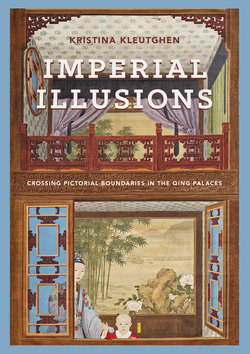Читать книгу Imperial Illusions - Kristina Kleutghen - Страница 97
На сайте Литреса книга снята с продажи.
Оглавлениеstatement in favor of the ruling Qing, recalling two leaves from Yongzheng’s well-known album of twelve costume portraits. One album leaf depicts the emperor in Mongol winter costume similar to Nian’s figure (figure 2.16), although without the slit robe skirt and with the conspicuously Mongol addition of a gold hoop earring. The stalking tiger is depicted half-hidden in the leaf that depicts Yongzheng in Western dress (figure 2.17), one of two portraits in this costume that further illustrate his interest in Western things. Tigers were common prey for the Manchus and Mongols in the hunting grounds north of the Great Wall, eagerly sought in a non-Han activity that underlined the Manchu ethnic and cultural relationship with the Mongols as peoples originating north of the historical Chinese border. Whether or not Nian was aware of the costume album, by depicting such subjects directly related to the Qing, both politically and artistically, he advertises his personal connections to the imperium as a bannerman, and perhaps even his proximity to Yongzheng in particular.
From perspectival spaces and paintings meant to transform walls and ceilings, to objects in three dimensions with mass and volume that cast shadows, all the illustrations in The Study of Vision are meant to teach pictorial illusionism and the deceptive effects achieved by using Western pictorial methods for Chinese subjects. Rather than a title that describes it as a study of linear perspective or Western painting, Nian’s chosen title, The Study of Vision, emphasizes the ultimate effects of these pictorial techniques. With varying degrees of clarity and legibility, the illustrations and instructions demonstrate the technical methods that can be manipulated to produce visual deception in painting. Correlating the illustrations in his nine sections with the two prose prefaces confirms that Nian sought to investigate the techniques of linear perspective, modeling through shading, and cast shadows in the service of a more profound investigation into visual perception and cognition inspired by this foreign painting style.
Perception, Cognition, and Perspectival Illusionism
Although the illustrations are the most important part of the treatise, the prefaces establish how Nian contextualized his discussion of illusionistic painting methods by focusing on their effects. By not consistently linking Nian’s statements in the prefaces with what he does in the illustrations, the previous translations have privileged words over images in a way that contradicts Nian’s own methodology. Therefore, in light of the information found in the illustrations, Nian’s two distinctly different prefaces to The Study of Vision deserve a fresh translation.75
In the 1729 preface, Nian wrote,
For many years I have focused my heart and mind on the study of vision. While attending to my post, I thought about it exhaustively, all without achieving even a glimmer
